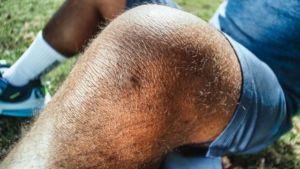
Many people who struggle with joint pain feel worse during cold weather months. Achy knees, hips, or elbows can put a crimp in your holiday plans and leave you feeling fatigued. What if you could enjoy life again without the pain? Joint injections are an effective, safe approach to pain relief. Here are three types of joint injections to consider with your healthcare provider.
1. PRP Injections
PRP or platelet-rich plasma injections are among the most effective and versatile injections for joint pain. They can be used in the knee joint, and to treat tennis elbow and plantar fasciitis. PRP consists of plasma (the liquid portion of blood) and platelets collected from the patient. Platelets are specialized cells that use chemical messaging to attract immune cells, stimulate collagen production and perform other actions needed for healing.
PRP injections jump-start the body’s healing processes and fix the underlying cause of your pain. Injuries to joints, tendons, and ligaments are often slow to heal on their own because they don’t receive robust blood flow. PRP bypasses that problem by directly delivering the healing agents found in the blood to the injured area. Natural healing takes time to work, so patients usually begin to feel a difference within a few weeks of receiving their initial treatment. It’s worth the wait because the effects of PRP are long-lasting. Acute injuries that have been slow to heal may heal completely. Chronic problems like arthritis usually require a once-a-year booster shot to maintain pain relief.
Unlike surgery or prescription pain medication, PRP rarely causes side effects. Since it uses the patient’s own blood, it doesn’t cause allergies or rejection. As long as a licensed provider is performing the procedure, the risk of infection at the injection site is extremely low.
Patients who have tried other treatments without success are great candidates for PRP injections, as are people who are sensitive to steroids and other medications. It is also an excellent first-line treatment for people experiencing arthritis symptoms. Using PRP during the early stages of arthritis can slow progression and provide longer-lasting relief than some other therapies.
2. Hyaluronic Acid Injections
You may have heard of Hyaluronic acid (HA) in commercials for skincare products. It’s a substance produced naturally by the body that plumps up the skin and lubricates joints. Our bodies produce less of it as we age, leading to sagging skin and creaky joints. Luckily, we can make up for this deficit with hyaluronic acid injections. Right now, it is mainly used to treat the knee joint, but as research progresses, it may someday be used in other joints as well.
When HA is injected into the knee joint, it reduces inflammation, forms a protective coating around nerves, and lubricates and cushions the joint. This protects the cartilage and can slow degeneration in patients with mild cartilage damage. Some arthritis patients notice significant pain relief when HA is used independently. Others notice a slight improvement that can be increased by using PRP alongside HA. Studies indicate that when these two treatments are used together to treat osteoarthritis in the knee, patients notice a substantial decrease in pain, and imaging shows less degeneration a year later than would normally be expected.
Like PRP, hyaluronic acid injections induce a natural process that takes time to complete. It can take several weeks to see peak pain relief, but many patients feel some relief within two weeks of the treatment. HA injections are also extremely safe. The most common side effect is temporary pain or swelling near the injection site. After the initial series of shots, most patients experience relief for about six months, and for some, it lasts even longer.
Hyaluronic acid is often helpful for patients who have not experienced relief with over-the-counter pain relievers or other treatments. In patients with early-stage arthritis, HA alone or combined with PRP can relieve pain and slow progression.
3. Cortisone Injections
Cortisone shots are among the most well-known and oldest treatments for joint pain. They use a type of steroid that the body produces naturally to reduce inflammation. Often, inflammation is the primary source of joint pain. In these cases, cortisone shots are very effective and can be used to relieve acute symptoms and manage chronic pain.
Inflammation is part of the body’s natural healing process, but too much inflammation can slow healing and prevent enough blood supply from entering the injured area. Cortisone shots reduce this inflammation so the body can finish healing. Patients with joint pain due to an injury often only need cortisone shots for a few weeks or months. Patients with chronic conditions like arthritis will not experience complete healing and will need cortisone shots every few months to keep their pain manageable.
Many people can receive cortisone shots for a short time without side effects, but some are sensitive to steroids. Talk to your provider about any reactions you’ve had in the past to steroidal drugs. The main downside of cortisone shots is that they can only be given three or four times per year. This is because the risk for side effects increases if they are given more frequently. Patients who experience pain relief for several months after a cortisone shot are the best candidates for this treatment. People with chronic conditions who don’t experience long-term relief with cortisone are good candidates for other treatments like HA and PRP injections.
Despite some potential drawbacks, cortisone shots have been proven effective for decades and are safe to use in moderation for most people. They can also be used in nearly any joint and in the back. If you are struggling with a joint injury, cortisone is an effective and economical option.
Joint Injections in Houston
At Vanguard Spine & Sport, our experienced providers thoroughly evaluate joint injuries and provide safe and effective treatments. We have seen many patients go from experiencing constant pain to feeling well again after receiving joint injections. Schedule a consultation today and make 2022 the year that you finally get rid of your pain.




